June 20, 2013: As the weather is reaching its climax of heat and humidity, Padayatra India takes a well -deserved one week break and visits Nepal.
The northern region of Nepal has eight of the world’s ten tallest mountains, including the highest point on Earth, Mount Everest. It contains more than 240 peaks over 20,000 ft (6,096 m) above sea level and is world renown for its trekking routes. Nepal is also famous for the Kali Gandaki Gorge, the deepest gorge on earth. Besides having the world’s tallest peaks, Nepal also has its rich cultural heritage rooted in the Hindu and Buddhist religions. Full of various pilgrimage sites, Nepal was the last officially declared Hindu country until there was a recent change of power from monarchy to democracy. Year
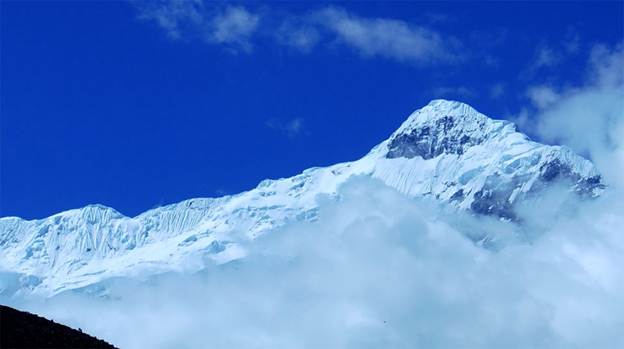
1- Mountain peaks of Nepal (at Muktinatha 3,800 meters above sea level)
On the 6th of June a roup of 22 padayatris, including a few visiting guests, walked across Nepal’s open border from Barganiya (Bihar), a small town touching Nepal’s border. Devotees performed harinam sankirtan as a few interested border security guards bought books from the distributors. India and Nepal are in good terms and have their borders open for each other. People of both nations can easily go to and fro without unnecessary interrogations or checking of visas.
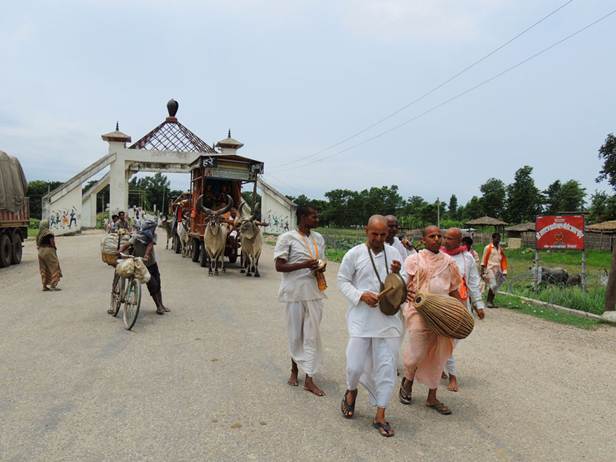
2- Walking across the open border of India and Nepal
We soon arrived at our day’s halt, a town named Gaur . Devotees were elated by the special name of the town,”Gaur”. The local radio channel promptly reported our entry into Nepal as we walked past its broadcasting office. Definitely, Sri Sri Nitai Gaurasundar had showered their blessings upon the residents of Gaur. ISKCON has a centre there in the market, with small deities of Sri Sri Goura Nitai. Under the guidance of Keshava Gopal Prabhu a handful of strenuously working devotees are preaching there to please Srila Prabhupada and their Lordships. They warmly welcomed and pampered us.
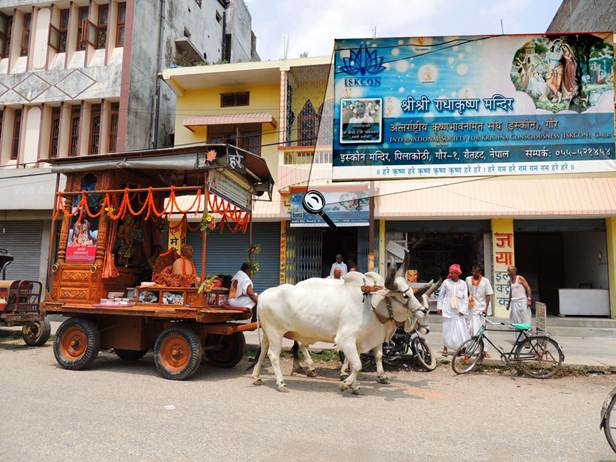
3- Padayatra at ISKCON Gaur (Nepal)
Our plan was to visit some prominent pilgrimage sites of Nepal, which means lots of mountains and bad roads. We would have loved to take along our oxen and Nitai Gaurasundar’s cart but we had to leave them in a safe place for a week’s time till we returned. The devotees of Gaur found for us a suitable place, a new ISKCON temple construction site at Bhunkunma, just 6 kilometers away. So we moved everything there the next day and ensured that the bulls were being comfortable in the sparsely populated construction site. It was an ideal location for a week’s halt with a large open ground, lots of fresh grass and mango trees besides the vegetable groves nearby.
As the oxen happily munched on fresh grass, all the devotees, except one pujari and one ox caretaker, prepared to board our overnight bus to Kathmandu, the nation’s capital. Overnight bus journeys are never comfortable, and this journey was no exception as we tried to get some sleep. Somewhere past midnight our bus bumped into some pits and gravels, which woke up some devotees, who then got to see the astonishing silhouettes of the mountains and river. We were approaching the great Himalayas, which have stood witness to millions of years of history and sheltered innumerous sages and ascetics in their attempts and practices of severe penances to link oneself to the Supreme Being through yoga. As we tried to get a little more sleep the sky soon began lighting up and we resorted to chanting our japa. We reached ISKCON Kathmandu, the Sri Sri Radha Govindahari temple situated in a serene locality, higher in the hills beyond the city centre. We felt the fresh breeze and homely atmosphere as a welcoming into one of the heavenly planets.

4- Sri Sri Radha Govindahari (ISKCON Kathmandu)
After being accommodated in a spacious guest room the devotees prepared for the day’s visit of Kathmandu’s prominent pilgrimage sites. The most popular is the Pashupatinath temple of Lord Siva. Here Lord Siva blesses all those who come to see him that they will never glide down to the animal species. Devotees entered the temple with loud chanting of the holy names, gathering large amused crowds and a few enthusiastic participants. Our small padayatra’s Sri Sri Nitai Gaurasundar danced Their way and entered the temple to meet and bless the topmost Vaisnava, Lord Siva.
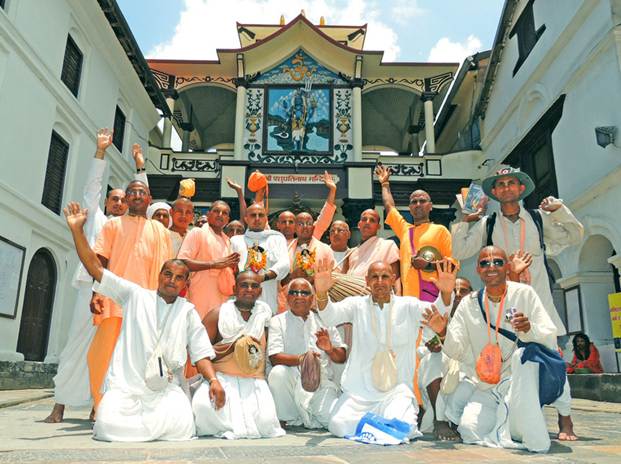
5- In front of Sri Pashupatinath Temple
Being an ancient temple with a large Siva linga with four heads turned towards the four directions, it has strict conservative rules of no photography, and only Hindus allowed. Krishna Sudama das, a foreign bodied devotee, somehow got in without the security noticing but was later on asked to leave the temple premises, after being spotted by an old priest. He didn’t make much of a fuss as he fortunately had his desired brief darsan of the Siva linga and had walked around the temple. A similar incident had occurred when Radhanatha Swami had visited this very temple some forty years back. Maharaja describes this incident in his autobiography, “Journey Home”. Maharaja was wandering through Nepal on his treacherous search for the ultimate truth when he came upon a great festival in the honor of Lord Siva. Many thousands of Shivaites and Naga Babas were flocking at the Pashupatinath temple to seek the blessings of Lord Siva and duly worship him. Naturally Maharaja also wanted to participate but was denied entry in the temple. So he resorted to smearing ashes over his body and got very near the main Siva Linga. Just then a priest suspected him and asked something in the local Nepalese language. Maharaja cleverly gestured that he was maintaining a vow of silence and instead of getting into trouble was greatly respected by the priest who garlanded him.
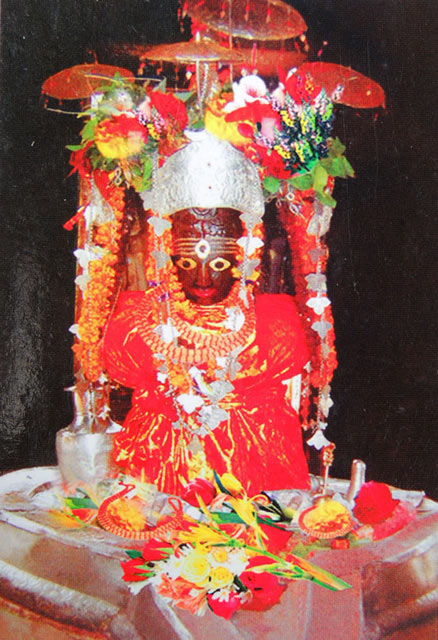
6- Pashupatinath Siva
Behind the temple is a cremation ground with the sacred Baghmati river flows. Many deceased bodies are cremated here, whose ashes are then released in the sacred river.
Our next visit was the Budha Nilkantha temple very close to our ISKCON temple. This temple is believed to be over 1,000 years old. Lord Visnu is about 5m (17 ft) long and is lying in a 13m (43 ft) long tank, as if floating, with His legs crossed. His four hands hold the four symbols of Visnu: the chakra (disc), club, and conch-shell and lotus flower. The deity of Budha Nilkantha was lost for a while and was later rediscovered by an old farmer named Nilakantha. It is believed that the farmers struck the buried deity with his plough and that blood came out from the ground. Hence forth, the deity has been known as Buddha (old) Nilakantha (name of the old farmer).
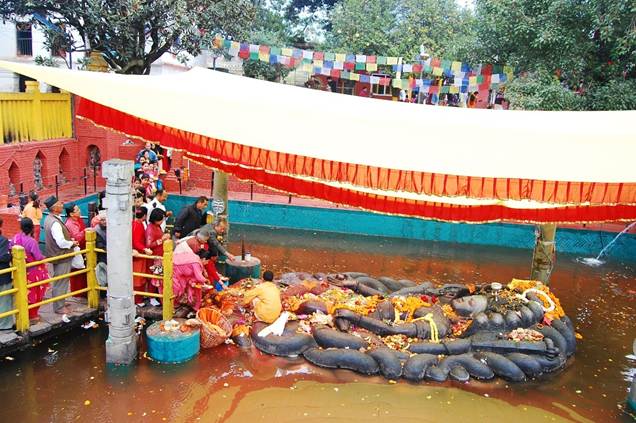
7- Buddha Nilakantha
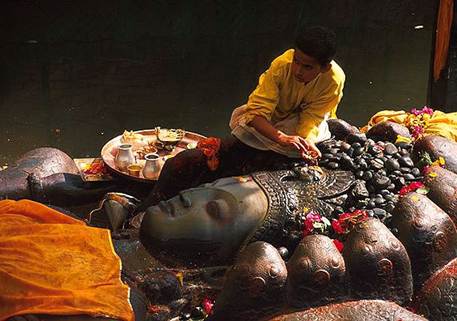
8- Buddha Nilakantha with many Shaligram silas
Our main destination was the famous temple of Sri Muktinatha Visnu, situated at an altitude of 3,800 meters above sea level. A road was recently created for vehicles, but only mini busses and jeeps were allowed on it. This road isn’t made of asphalt but of the mountain’s rocks and dirt, which turned our journey into a three-day halt before we could get the auspicious darsan of Lord Muktinatha. Although there is an airport with helicopter services provided by the Nepal government, these are highly risky and a bit heavy on the pocket. Just a year ago, a group of twelve congregational devotees from the Sri Sri Radha Gopinatha ‘s Chowpatty temple in Mumbai had attempted to fly to Muktinatha for a darsan but unfortunately their small plane crashed in the hills near its destination and there were no survivors. The benefit of pilgrims having darsan of Lord Muktinatha is that He grants them liberation from this material world. Of course, devotees don’t want liberation but rather they hanker for eternal devotional service, whether it is in the spiritual or material worlds as per the will of the Lord. With this mood we padayatris joyfully engaged in this great adventure.
Our first halt from Katmandu was the second largest city of Nepal named Pokhara. It’s a hub of higher education, jobs and sightseeing. Nepal is rapidly being influenced by the cheep Chinese culture with all its gadgets, automobiles and fashion. It’s hard to imagine that Nepal was once ruled by ancient Hindu monarchs as we see the rapid influence of television and the western dressing scene spreading. Pokhara is highly influenced by these and youngsters zipping on their Chinese motocross bikes are a common site here. Fortunately ISKCON has a beautiful two storied centre near the main market at Siddhartha Chowk. It’s run by a sincere young brahmacari by the name of Urukrama Prabhu (disciple of HH Mahavisnu Swami) and it has a few college youths and a small congregation.
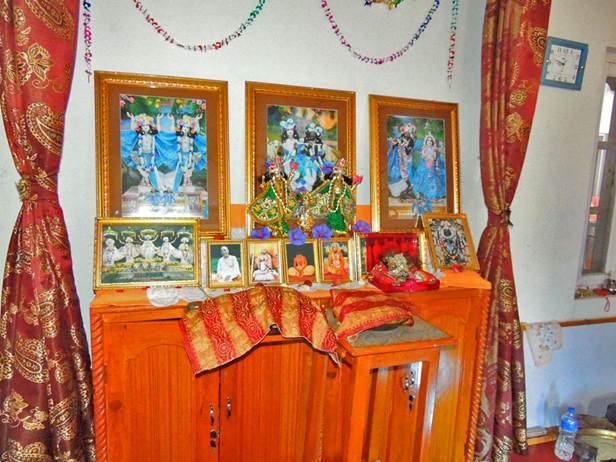
9- ISKCON centre at Pokhara (with our Nitai Gaurasundar on the altar)
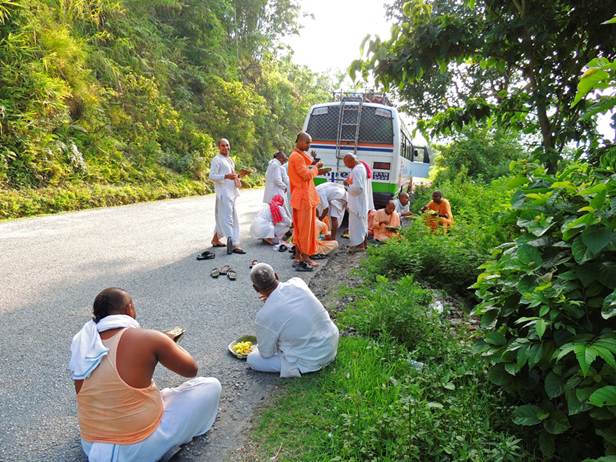
10- Prasadam on the way to Beni
From Pokhara we took a public bus to Beni and boarded a mini bus to Ghasa where we halted the second night. We stayed in a cozy inn having a separate quarter of twenty beds, just suitable for the padayatris. The fresh cool breeze of the valley was rejuvenating and a gift for all of us from Sri Sri Nitai Gaurasundar. Devotees were enchanted with the natural beauty of the hills. Then we embarked on the next leg of our journey towards Jomsom, some 35 kilometers ahead. But these 35 odd kilometers took us a long six hours as the mountain roads are very bumpy and curvy. Mountain journeys are very tiring but the devotees were somehow or another engaged in Krishna consciousness either by reading, chanting, hearing or doing harinam sankirtan. We also requested our bus drivers to play Aindra Prabhu’s and Lokanatha Swami’s bhajans the whole way.
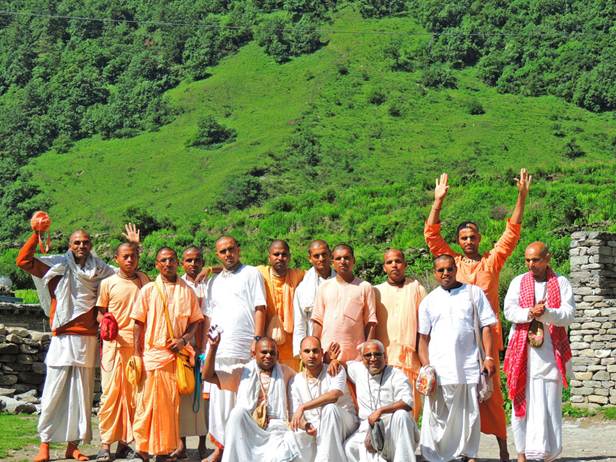
11- A halt on the way to Muktinatha
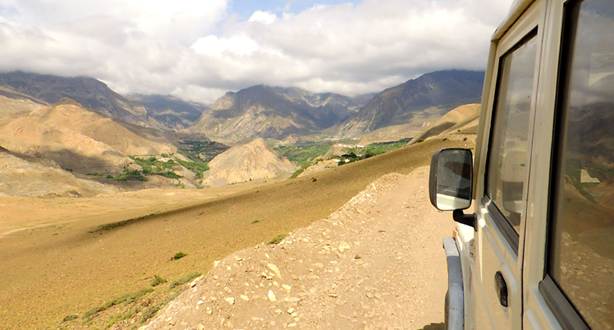
12- Drive to Muktinatha
After our long journey we reached Jomsom ( 30 kilometers before Muktinatha ) where we prepared our lunch prasadam at a Ramanandi ashram (part of the Sri Sampradaya) before catching our jeep to Muktinatha. Upon reaching Muktinatha we left our bags in another Ramanandi lodge and rushed up to have our darsan of Lord Muktinatha.
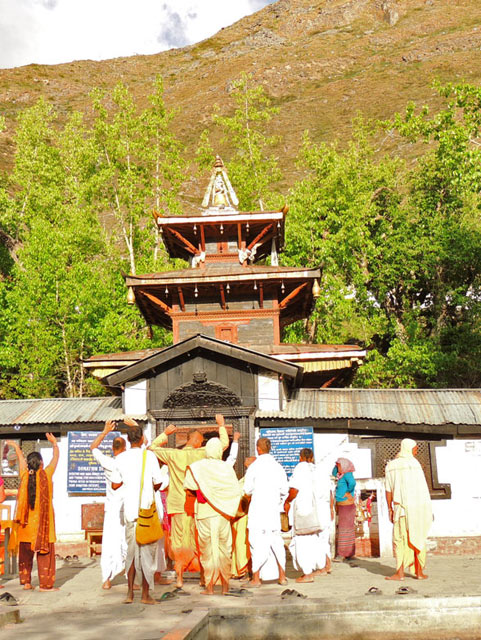
13- Devotees in front of the Muktinatha temple
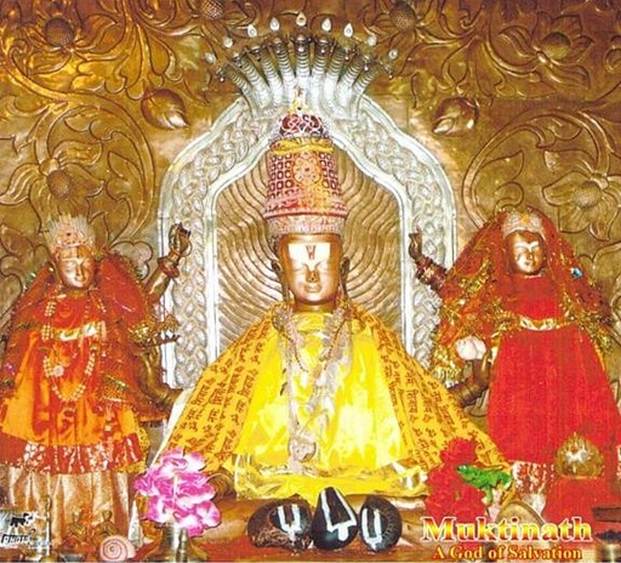
14- Deity of Lord Muktinatha with Sri Devi (on our right) and Bhu Devi (on our left)
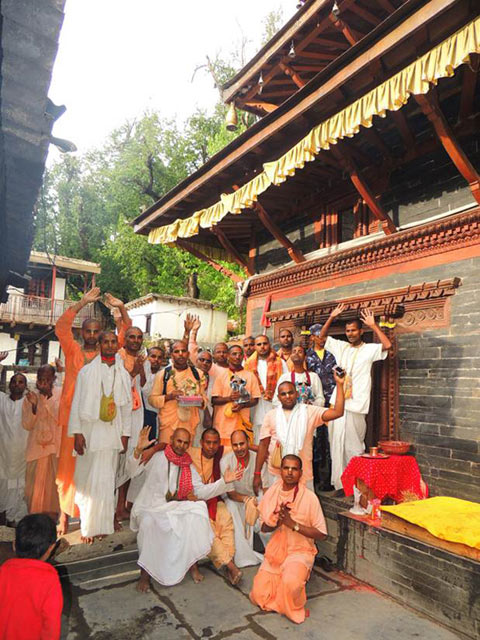
15- Padayatris at the Muktinatha temple
In the temple we performed a loud kirtan and had a close darsan of Sri Muktinatha along with His energies, Sri Devi and Bhu Devi. We could not take a photo of Sri Sri Nitai Gaurasundar sitting on Lord Vishu’s lap, because unfortunately photography isn’t allowed. An interesting agreement is seen here between the Hindu and Buddhist priests who take turns to worship the deity in the mornings, mid day and evenings. The local Buddhists believe this deity to be Lord Buddha’s form, whereas Hindus believe Him to be their worshipable Lord Visnu. The Lord is accepting service from both groups while reciprocating correspondingly. How wonderful is Lord Muktinatha! Another point of significance is the 108 streams of holy Gandaki water flowing through the 108 cow faces at Lord Muktinatha. One is expected to bathe in these 108 streams, but after touching the ice cold water only three devotees took the courage to have a quick dip.
Muktinatha is also famous for the Gandaki River in which Shaligram silas are found. Many sadhus from all across India travel here on foot in order to receive the lord in his Shaligram form which doesn’t even require a ritualistic installation. It is stated in the scriptures that the lord ever resides in the Gandaki river in his Shaligram form and many various shapes are carved on him by small insects living there. There is a vast history about the origin of Shaligram and how Lord Visnu was cursed by his devotee named Tulasi, which can be found at http://www.iskcondesiretree.net/profiles/blogs/wonderful-info-on-shaligram-shila and http://en.wikipedia.org/wiki/Gandaki_River.
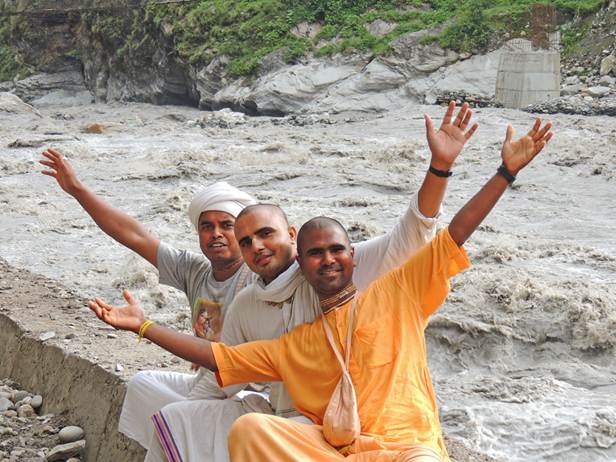
16- Avadhuta Nitai, Bhakta Pawan and Partha Sakha next to the Gandaki River (left to right)
We spent one night at Muktinatha covered up with blankets. As many devotees began developing colds and fever due to the cold and the altitude, we decided to go back down.
We had scheduled a grand harinam procession through the main market of Pokhara which was happily received by the locals. Sri Sri Nitai Gaurasundar led the way as devotees danced and chanted to the loud kirtan. There was lots of book distribution: a total of over 40 Gitas and many small books. This is one place which really needs the mercy of their Lordships and we pray that Krishna Consciousness in Nepal will rapidly expand.
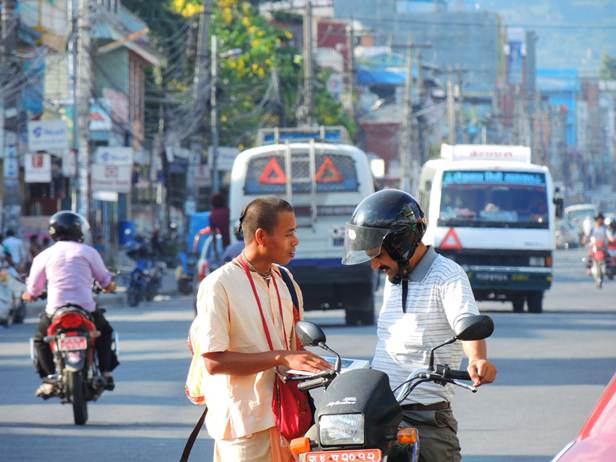
17- Abhiram Gaur prabhu distributing books
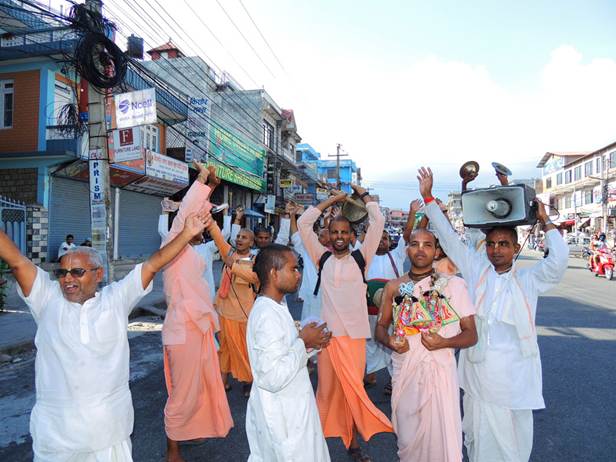
18- Harinam Sankirtan in Pokhara
Padayatra India really enjoyed the hospitability of the devotees in Nepal and is planning to visit again and travel on bullock cart in its plains accessible to the cart. Why miss all the fun? Quick, come join Padayatra India for a lifetime’s spiritual experience of adventure and bliss. We will now be travelling towards Patna where we will celebrate Lord Krishna’s Janmastami festival at the ISKCON Temple. See you soon!
